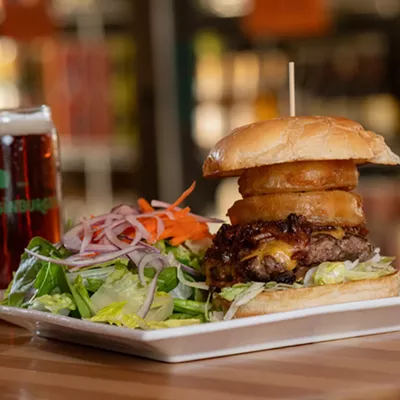Hockey has long been a vibrant part of the Spokane sports scene. But long ago, the city blew its one and only shot at major league sports when the Spokane Canaries -- that's right, Canaries -- brought big-league hockey to town for one spectacular flop of a season.
Spokane was a bustling lumber, farming and mining center, home to perhaps 135,000 hearty souls, when legendary hockey pioneer Lester Patrick moved his Pacific Coast Hockey Association franchise from Victoria, British Columbia, to Spokane in 1916. A new arena (later known as the Elm Street Arena), one of the first with artificial ice, was built across the street from Cannon Park in West Central Spokane.
The fact that the arena lacked a roof may have been the first indicator that big-time hockey was not long for Spokane. The Canaries struggled to draw 1,000 fans to watch future Hockey Hall of Famers like Patrick (Spokane's coach, general manager and star defenseman), Dick Irvin of the Portland Rosebuds, Frank Foyston of the Seattle Metropolitans and Cyclone Taylor -- hockey's first superstar -- of the Vancouver Millionaires.
The Stanley Cup, hockey's grandest prize, was awarded each year to the winner of the playoff series between the champions of the PCHA and the National Hockey Association. The PCHA, founded in 1911 by Patrick and his brother Frank, instantly gained major league status by raiding the NHA (which became the NHL in 1917-18) for top players like Taylor.
It is difficult to imagine in today's world of the almighty dollar's impact on sports, but Spokane could have been host to the 1917 Stanley Cup finals. The site of the finals alternated each year between the home of the PCHA and NHA champs, and the Canaries held first place as midseason approached in a year when the Stanley Cup playoffs would be staged out west.
The Canaries improved to 6-4 and replaced Seattle atop the PCHA standings by defeating the visiting Metropolitans 5-1 before an estimated 1,000-plus spectators on Jan. 5, 1917. However, the Canaries lost all but two of their remaining 13 games to finish last in the four-team league at 8-15.
Seattle, in fact, went on to win the Stanley Cup by defeating the Montreal Canadiens in an arena located at the present site of the famed Olympic Hotel in downtown Seattle.
The Canaries drew so poorly that their final three "home" games were played on the road. Arena owner Thaddeus S. Lane told the Spokesman-Review that the Canaries drew "favorably" compared to other first-year teams and would "definitely" return in 1917-18, but the franchise folded soon after the season ended.
Attendance reports were sporadic in the Spokesman, but the highest number reported -- always a round figure, and without listing a source -- was 1,500 for the second home game. No attendance figure was given for the Jan. 12 contest, when the Review reported "a crowd fully 50 percent larger than any that witnessed a hockey match in Spokane was present."
Of course, that's not saying much in a town where the newspaper reported that 3,000 spectators turned out for the first day of the annual city pocket billiards tournament. The Spokesman gave considerable coverage to the Canaries during an era when the sports "section" usually consisted of less than one full page, but much space also was devoted to local bowling, trapshooting, billiards, handball and even indoor baseball.
The Spokane arena's capacity was listed at various times at 2,300 to 4,000, and newspaper reports gave no indication that the Canaries ever drew a capacity crowd. Just 700 fans reportedly turned out for Spokane's first-ever pro hockey game, a 6-4 win over Taylor (who had a goal and assist) and the Millionaires. Three days later, the Review printed the first of several articles warning that larger crowds were necessary to keep major league hockey in Spokane.
A booster club was quickly formed, and local businesses purchased blocks of tickets to support a team the paper took to describing as "yellow-sweatered stick artists,'' "haughty speed boys" and "Lester Patrick's puck retrievers." Students were eventually offered tickets for just 25 cents, and half-mile and mile skating races were held between periods in an attempt to boost crowds.
"The high price has become a stumbling block to many who are curious to see the new league, but not to the extent of $1," the Review reported.
That might have been a valid point. After all, the Canaries' standard ticket prices ranged from 50 cents to $1 -- and that was for sitting in a roofless, unheated arena. Half a century later, the Spokane Jets brought senior amateur hockey back to town in 1963 (after a five-year break for minor-league pro hockey) and charged 50 cents to $1.65 for tickets in the modern Spokane Coliseum.
At least one Canaries game was played in zero-degree weather. The Spokesman reported that 1,000 fans turned out for a 6-2 win over Portland.
"So excited were the spectators that they didn't have a chance to get cold," the Review opined.
Overall, however, the Inland Northwest's only major league sports franchise received a chilly reception in Spokane. Lester Patrick went on to fame and glory as coach and general manager of Stanley Cup champions with the New York Rangers. Spokane did not lure another pro hockey team until the minor league Oakland Clippers moved to town in February 1937. That summer, a roof was finally built over the Elm Street Arena.
Publication date: 1/08/04

















